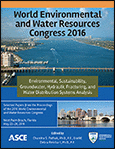Qualitative and Quantitative Evaluation of Sarayan Aquifer in Northeast Iran Using Groundwater Flow and Transport Models with GIS Interfaces
Publication: World Environmental and Water Resources Congress 2016
Abstract
The Sarayan region situated on the edge of the Lut desert in central northeast Iran within the Southern Khorasanprovince, is an agricultural area with limited water resources almost exclusively from groundwater aquifers. Until two decades ago very limited information about the characteristics of the region’s aquifer and the sustainable yield and quality of the groundwater in the area existed. To get a better handle on the availability of groundwater and its quality, an extensive study of the region was initiated in the late 1980s. The study consisted of intensive water level monitoring and sampling for water quality (salinity of the aquifer water) for later analyses. The information collected was later used to develop a conceptual model of the basin and subsequently a mathematical model of the area to perform various simulations to look at scenarios for long term water resources management in the region. The basic hydro-meteorological data about the region include the mean annual temperature and precipitation within the basin that are 15.5ºC and 170 mm (60ºF and 6.7 in.), respectively. Precipitations mostly occur in late fall and winter seasons often in an intense short duration episodes. There are no perennial rivers in the area, though some floodway tracks run north to south draining the region’s northeastern hills with the Qasemabad saline floodway the most significant feature. In the southern part of the Sarayan region, the aquifer also provides some base flow to the Qasemabad desert that quickly evaporates leaving salt flats behind that could become airborne causing air quality issues periodically. Total basin area and perimeter are 2710 km2 and 277.6 km, respectively. Groundwater in the Sarayan plain occur in an unconfined aquifer within an aerial extent of 748 km2. Aquifer materials are composed of various alluviums such as coarse grain alluvial fan deposits, sand dunes and flat clay fine sediments. In general, the aquifer materials tend to be finer moving toward the south and hence hydrodynamic parameters such as hydraulic conductivity decrease in a southerly direction. The mean annual rate of drawdown in the past 30 years has been about 75 cm (~2.5 ft), which has reduced the aquifer extent (domain) continuously. This paper will provide the background on the project, the basis for conceptual model development and the construction of the mathematical model for aquifer assessment, and testing scenarios for sustainable exploitation of groundwater resources.
Get full access to this chapter
View all available purchase options and get full access to this chapter.
Information & Authors
Information
Published In
Copyright
© 2016 American Society of Civil Engineers.
History
Published online: May 18, 2016
Authors
Metrics & Citations
Metrics
Citations
Download citation
If you have the appropriate software installed, you can download article citation data to the citation manager of your choice. Simply select your manager software from the list below and click Download.
